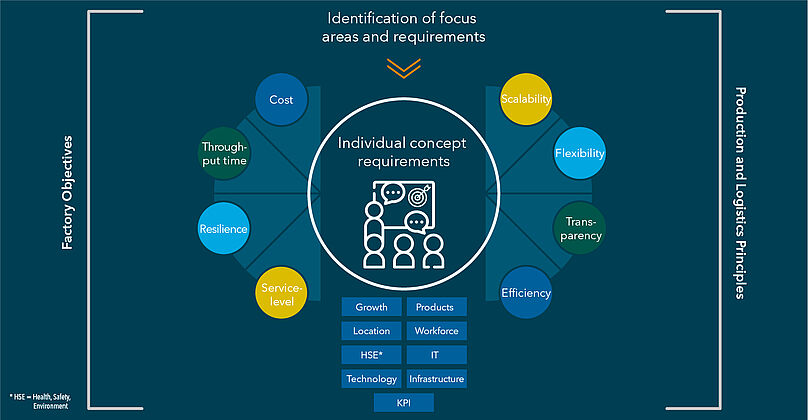- Consulting
- Logistics & production
- Plant structure planning
4flow consulting
Plant structure planning
Regardless of whether a plant has greenfield or traditional structures, each structure planning process begins with a few strategic questions about the target system: Which production strategy is being pursued? What range of articles or parts needs to be considered? What level of automation needs to be achieved? What does future growth look like? How many steps does implementation entail? Answering these and many other questions is necessary to clearly define the framework needed for all subsequent concepts and planning steps.
4flow works together with businesses during the entire planning process to design all relevant production and logistics dimensions: processes, structures & material flow, organization as well as information flow & IT systems. This is a process that considers industry-specific best practice plants and is supported by the latest innovative technologies.
Holistic planning approach to achieve optimal plant structure
Using a proven approach that has been tested and refined in more than 100 projects, 4flow develops a detailed plant structure. A range of possible solutions is narrowed down step-by-step based on individual strategic requirements and restrictions. Supply chain alignment, for example, is an important factor in this process. Is lead time or availability a top priority? How flexible and scalable does the system have to be? This strategic framework is the basis for all subsequent phases.
 Holistic factory planning approach
Holistic factory planning approach
During the concept phase of ideal and realistic planning, previously determined solutions are developed in greater detail. This phase starts by defining processes and structures along the value chain. The definitions are then combined in various functional areas and designed using a preliminary concept layout. At this planning stage, the level of detail is already considerably high in order to avoid overdesigning – and to ensure an optimal functional arrangement.

In the following functional arrangement and material flow planning phase, the planning process considers concrete restrictions, such as building column grids or the connections between secondary areas. The concept phase ends with the completion of this realistic planning stage and sets the stage for more in-depth planning. Using innovative tools and methods, the concepts are ultimately planned, and the entire plant structure is brought to the level of detail required for implementation.
Implementation planning and execution enables these detailed concepts to be realized. Over the course of many implementation projects, 4flow has developed a proven project management concept to support a seamless realization process and to ensure the timely operability of the plant.
Planning tools and methods
Innovative tools are used during all phases of the plant structure planning process to significantly increase planning efficiency and to ensure that all stakeholders have a good understanding of the detailed concept. With 3D visualization and optimization software, for example, results can be achieved, and alternative concepts can be evaluated rapidly.
Plant structure planning with 4flow for a smart factory
To remain competitive in the future, plant structure planning today must take future trends and developments into account. With many years of experience in successful digitization projects, 4flow experts ensure that automation and digitization technologies are optimally matched to every customer’s individual plant system.
What 4flow offers:
- Holistic plant structure planning approach, from strategy to implementation
- Use of state-of-the-art planning tools
- 10,000 cross-industry process benchmarks
- Many years of experience in intralogistics planning and implementation projects in various industries
- A global team of experienced intralogistics experts and practitioners
- Complete transparency about state-of-the-art technologies and future trends
